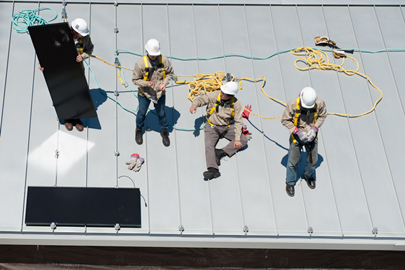
The Stanford Start.Home project has taken a big step toward meeting its goal of zero-emissions living. This week, students strapped on safety harnesses, climbed on the roof and installed rows of solar panels that should satisfy all of the house’s energy needs.
“You shouldn’t ever have to pay for electricity in this house,” said project manager Derek Ouyang, a student in the Department of Civil and Environmental Engineering.
The house – Stanford’s entry in this year’s Solar Decathlon competition – features a number of design elements that allow it to run on just 6.8 kW of electricity. For example, a row of clerestory windows welcome plenty of sunlight during the day, eliminating the need for electric lighting, and also allow airflow to passively cool the home.
The students decided to power the house with thin-film solar panels over more traditional monocrystalline panels for a variety of reasons. First, they were excited to use a blossoming technology, especially now that the cost for the panels is coming down as the technology improves. Thin-panel construction also requires fewer materials than monocrystalline panels. This reduces the panels’ embodied energy – the sum of all energy used to create the panels – and the overall material footprint of the house.
And it didn’t hurt that the manufacturer, San Jose-based Stion, was founded by a Stanford graduate.
“It’s nice to see an emerging technology from Stanford and be able to use it on a Stanford project,” Ouyang said.
Part of the Start.Home team’s larger goal is to reduce the cost of green construction. Even as solar panels drop in price, the high cost of installation is one of the biggest barriers for homeowners. Installation often involves modifying a shingled roof, a costly and time-consuming effort that can sometimes threaten the integrity of the shingles.
To overcome this cost, the Start.Home features a sheet metal roof with narrow ridges every few feet. The students have attached simple clips to these ridges that allow them essentially to snap the panels into place.
“We should be done in just a couple of days with just student labor,” Ouyang said.
Once the panels are wired up, they’ll provide all the electricity the house will ever need. They might even make some money. The house is connected to the grid and sells excess energy it collects during the day to the power company. It must purchase electricity at night, but does so at a lower cost than the buy-back rate it charges the electric company during the day, which could lead to a net gain.
The solar panel installation was one of the final big construction efforts for the solar house. Now the team will work on installing appliances, flooring, cabinets and other finishing touches, as well as implementing the Core, the central module that contains and manages most of the house’s mechanical, electrical and plumbing systems.
Later this summer, the team will open the house for public tours, and in the fall will truck the house south to Irvine, Calif., to be judged in the Department of Energy’s Solar Decathlon.
****************************************
Stanford Students Add Solar Panels to Their Zero-Emissions House,





